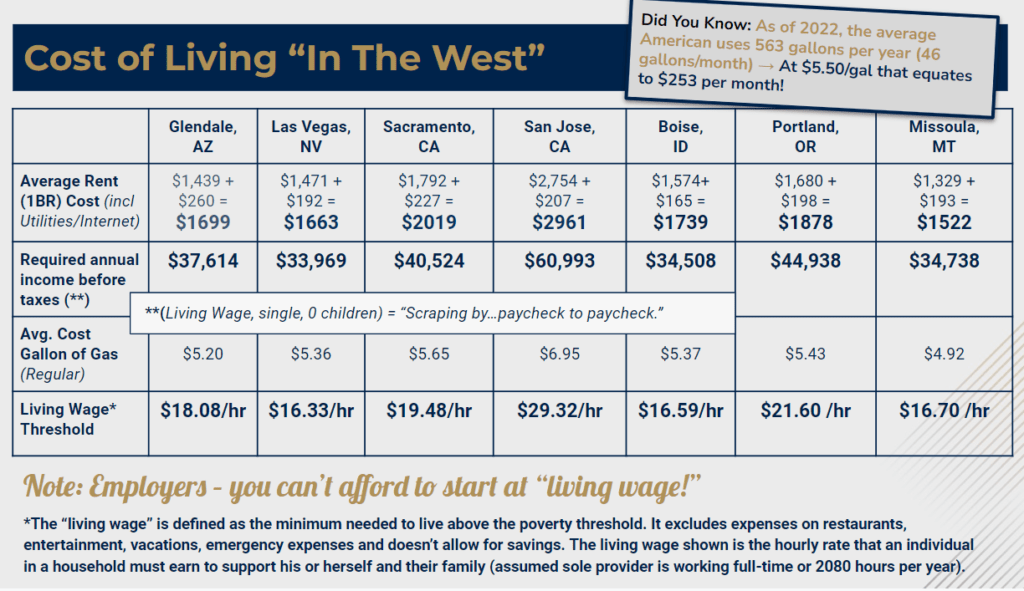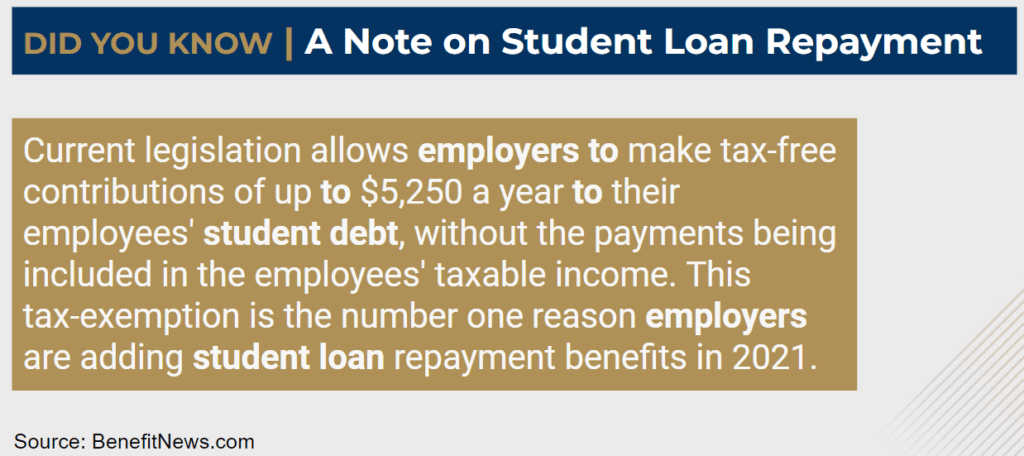In 2020, a single word became very prevalent in the world of Human Resources. We are all familiar with it if we have watched any of the news cycles. It even got a bit of hyperbole when pundits added “great” to the word. By now, you may know it is the word “resignation.” How did this become a megatrend? There are too many factors to lay out here but millions of people making individual choices creates a trend.
Naturally, this “resignation” wasn’t great for the overall labor force and it hurt the golf business’ labor pool. So, in 2021, the word of the year (at least in my world) became “poaching”. In the short term, this was great for young, talented and high-motor assistant professionals who saw new opportunities that were offering them more than they would have been paid prior to the pandemic. Within a few months of 2021, it became clear which facilities were ‘poaching capable’ and which were ‘poaching susceptible’. In most cases, it wasn’t about the quality of the facility or the strengths (or weaknesses) of the lead PGA professional or management, it was about:
- Combination of compensation and benefits (in relation to cost of commuting)
- Real or perceived career opportunity (e.g. title/role, who working for or with, club brand)
- Real or perceived opportunity for work/life balance.
In 2022, it still is the case. Here’s some selected images that may provide additional perspective in this current situation.
PGA National Membership Demographics
Highlights:
- Active membership fell 1% in last year
- Number of associates is growing (by 13%)
- Added 963 new associates
- Number of female PGA members up by nearly 3%
- Both Quarter Century and Half Century membership are growing
Takeaways: The PGA Recruiting efforts (including those by Caleb Hung, PGA) are working and creating results. More female members and more new associates. About one-half of the “net of the active membership” past 25 years of PGA membership. Which means, there is real opportunity for incredible career growth and positions for those who are willing to learn, grow and challenge themselves.
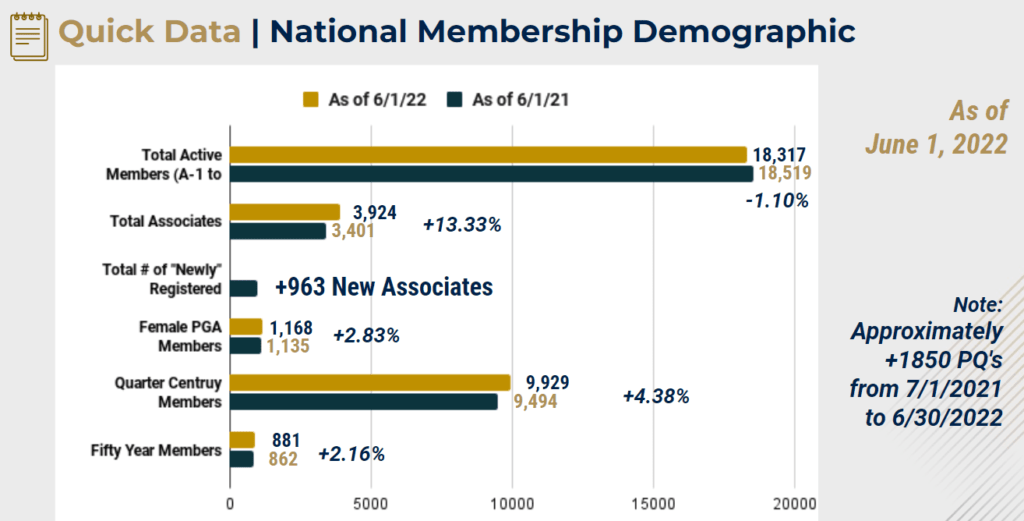
PGA 2021 Compensation Data Posted to the Job Board
Highlights:
- These are selected “Western PGA” Sections
- Figure 2 is SALARY POSTED positions for “Assistant Positions”
- Figure 3 HOURLY POSTED positions for “Assistant Positions”
- Note: These are for Lead Asst, 1st Asst, Entry-Level and general Asst positions
- Min Base and Max Base are before lessons, bonuses and incentives
Takeaways: Please note the difference Sections/markets which are fairly significant. Some of the “lower cost of living” areas (in a general sense) aren’t really that much lower than the much higher cost of living areas along the West Coast.
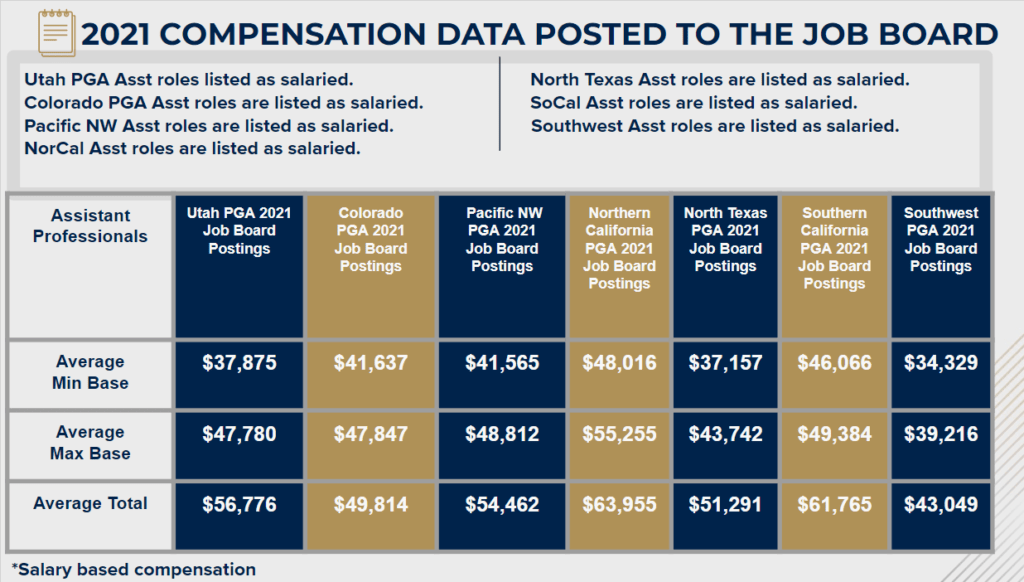
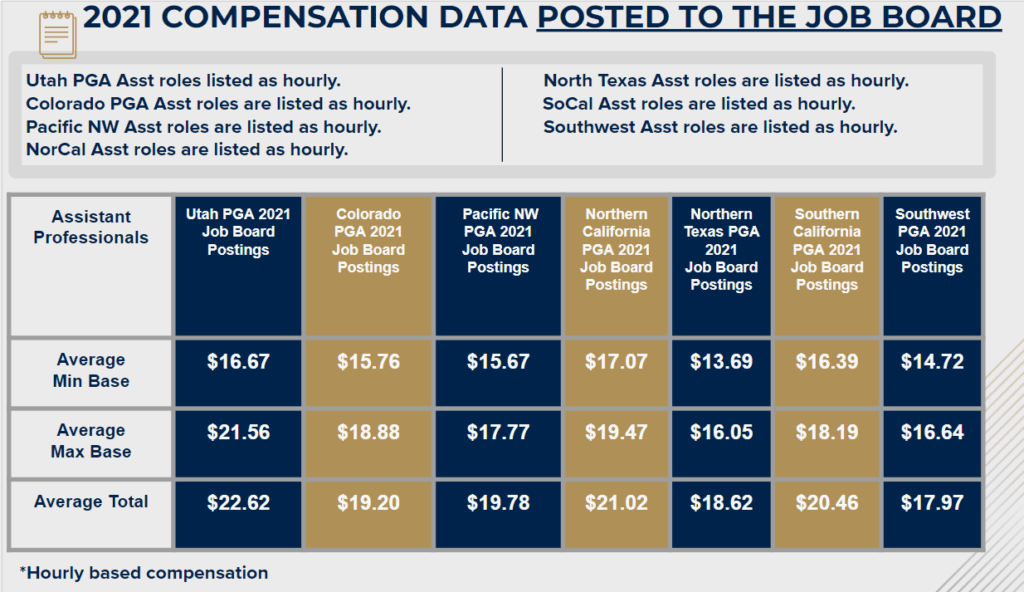
Cost of Living “In the West”
Highlights:
- Notice the difference in the “monthly rent (incl utilities/internet) for a 1BR apartment” and the “required annual income before taxes”
- Notice the average cost of fuel per month these days
- Notice the difference in the “Living Wage Threshold”
Takeaways: The percentage of income required for “basic housing and utilities” is significant across the board, and it is a higher percentage in some markets than others. We can’t “start posting jobs at living wage.” Living wage doesn’t mean “living well” or even “living okay,” it means “scraping by, living paycheck to paycheck” with no money for eating out, entertainment, vacations, savings, etc. This “living wage” valuation probably even lags behind the new cost differences in food, fuel and everything else.
So What Can You and I Do About This?
Well, unfortunately, when it comes to social megatrends, not that much. These are due to countless people making similar decisions based on the unique situation they have, their unique goals, preferences for where they live and specifically their career goals. In some ways, a simplistic but effective way to look at this would be: “If I’m in Missoula, MT and I’m looking for an entry level assistant professional, I have to start with the right “talent target.” (e.g. someone who loves golf, is already living in Missoula or nearby, probably has family in the area or similar support framework, etc.) With those attributes in place, it will likely be more about attitude, personality and coachability than the usual “skills and experience.”
In terms of Recruiting and Retaining Talent, there are a few good “near silver bullets” that top employers are doing when they are recruiting (aka poaching) and retaining (aka stopping poachers) their talent. These include (by type):
Compensation, Benefits and Other Concepts:
- Improved access to the facility (e.g. golf course, pool and fitness center) while educating the members/customers on the benefits of allowing this access (so we can keep our best people)
- Top value employees are given a weekly or bi-weekly $50 gas card or Visa-style cash card to offset their commuting expenses; some employers are “filling the tank” (1x/week using the tank on site) for their top staff
- When not in busiest weeks, create a four “10s” schedule and allow staff to work out their own schedule so they might be able to get three off from week one and another three days off from week two.
- Team building events (e.g. dinner out as a team, concert or sporting event as a team, or golf as a “team” at another facility)
- For staff who “close the shop” a lot, get a family meal delivered once a week for them to take home to their family (or friends)
- Student Loan Repayment can be viewed as more important than 401K contributions
- Arranging golf or similar experiences offsite with “lead professionals” network, (e.g. trading off to show value to each others teams; lead professional need not travel with them in some cases)
- Creating “staff-like” club and equipment scenarios so hourly staff get balls, clubs, shoes, etc. in a way that feels like they’re on staffShorter days just before and after holidays–work on shifts; brainstorm and be creative
- Healthy food options on the job; healthy options off the job
- Events that can involve the family or pets
- Discounts and/or barter with local partners: local events, concerts, hotel stays, dinners
- Signing bonus equal to deposit needed for apartment
- Professional development/ education expenses
- Paying a referral bonus to staff who “recruit good people” (after 90 days of successful employment)
Note: These types of benefits can help facilities that can’t otherwise afford a more robust benefit program as they are often seen as just as important to employees.
Other ideas for “Improving Time Off” include: Make Time Off a Reality (vs a Dream)
- Encourage employees to completely unplug on days off and when on vacation
- Encourage out of office on email and voicemail
- Communicate any details before the staff member leaves for vacation so they aren’t bothered with questions throughout their trip or day off
- Set a policy or put communication in place so employees know you are committed to this
- Encourage members to respect this policy as well
To wrap this up, next month we will be talking more about how we might want to think differently about “Work/Life balance” so we improve our own mindsets, attitudes and maybe be influential in the right way on those we work with and/or supervise. If you have any questions about these concepts above, or if you have any other concepts that you would like to share with me and others, please feel free to reach out to me soon.
Monte Koch, PGA Certified Professional, CEIP
PGA Career Consultant | PGA of America Career Services
mkoch@pgahq.com
206.335.5260
PGA of America
Business, Operations & Career Coach in the Pacific NW and Rocky Mountain PGA Sections
Lea Hill, WA
